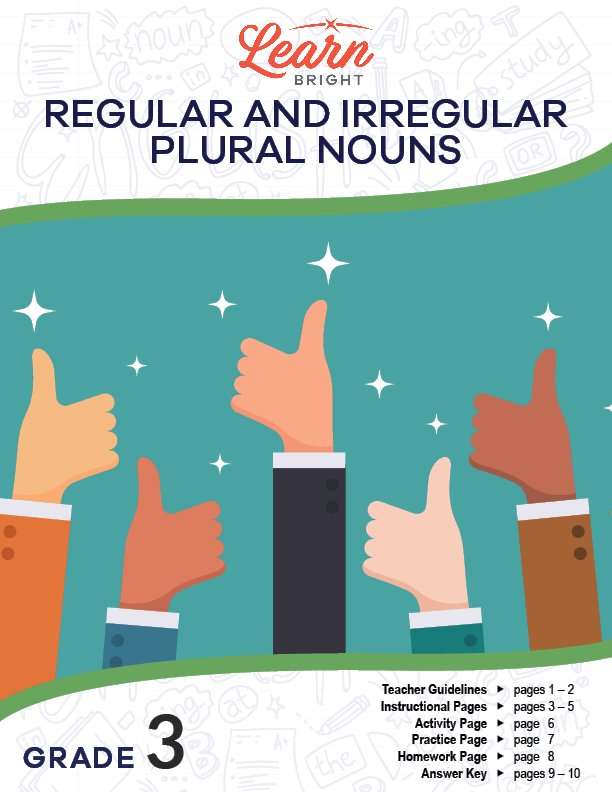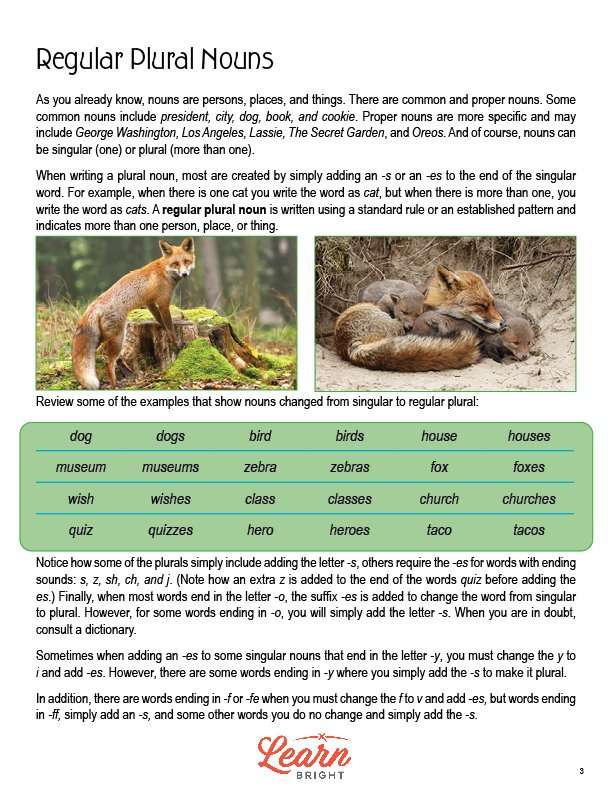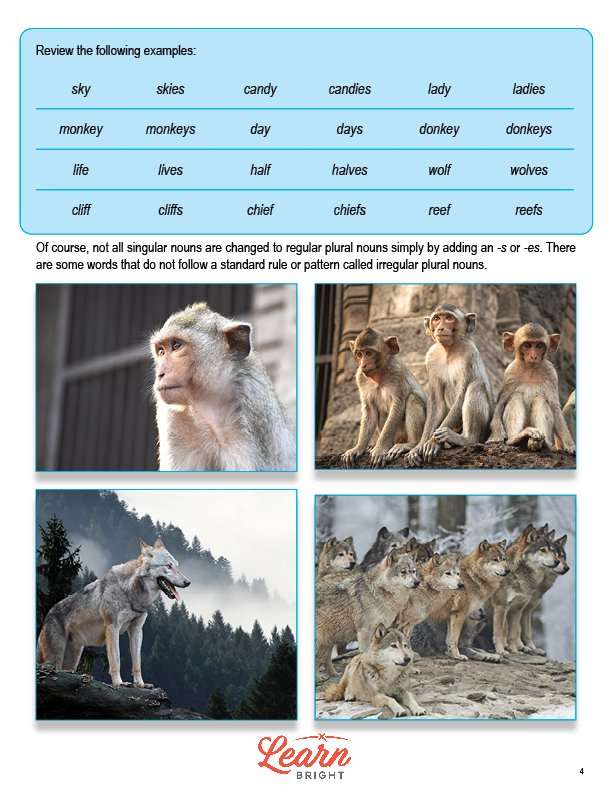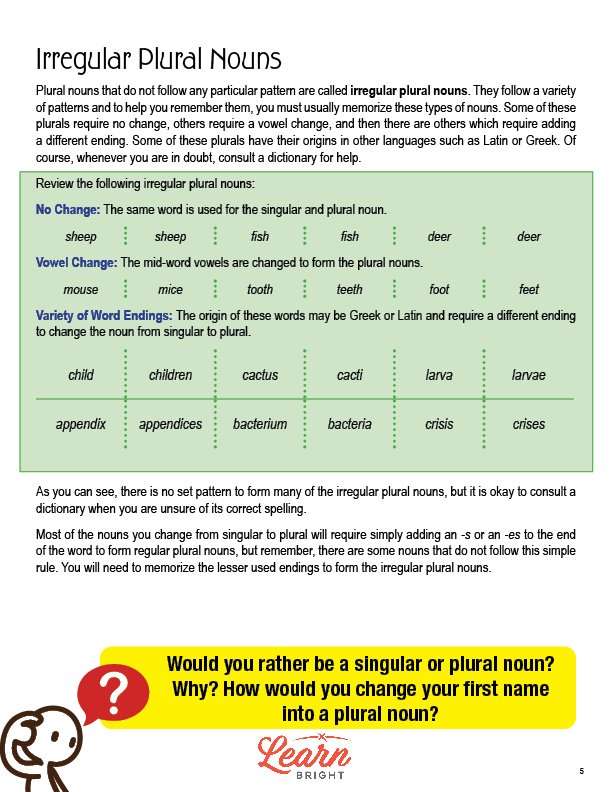Description
What our Regular and Irregular Plural Nouns lesson plan includes
Lesson Objectives and Overview: Regular and Irregular Plural Nouns teaches students how to change singular nouns into plural nouns, whether regular or irregular. At the end of the lesson, students will be able to form and use regular and irregular plural nouns. This lesson is for students in 3rd grade.
Classroom Procedure
Every lesson plan provides you with a classroom procedure page that outlines a step-by-step guide to follow. You do not have to follow the guide exactly. The guide helps you organize the lesson and details when to hand out worksheets. It also lists information in the green box that you might find useful. You will find the lesson objectives, state standards, and number of class sessions the lesson should take to complete in this area. In addition, it describes the supplies you will need as well as what and how you need to prepare beforehand. For this lesson, the supplies you will need are poster paper, colored pencils, and the handouts. To prepare for this lesson ahead of time, you can gather the supplies, pair students for the activity, and copy the handouts.
Options for Lesson
Included with this lesson is an “Options for Lesson” section that lists a number of suggestions for activities to add to the lesson or substitutions for the ones already in the lesson. The first suggested addition is for the activity worksheet and suggests that you can assign each pair of students one specific rule to create a poster for. You could have students use their current reading material to identify regular and irregular plural nouns. You can also hold a “Regular/Irregular Spelling Bee” where students spell both the singular and plural forms of words aloud. Students can also create sentences where they use plural words incorrectly, to be corrected by another student in the class. For an addition to either the practice worksheet or the homework assignment, you can have students write sentences using the words from those assignments. Finally, if your students are more advanced, you can have them research the origins of some irregular plural endings.
Teacher Notes
The teacher notes page includes a paragraph with additional guidelines and things to think about as you begin to plan your lesson. It notes that you might want to teach this lesson along with some other lessons about spelling or other lessons related to nouns. This page also includes lines that you can use to add your own notes as you’re preparing for this lesson.
REGULAR AND IRREGULAR PLURAL NOUNS LESSON PLAN CONTENT PAGES
Regular Plural Nouns
The Regular and Irregular Plural Nouns lesson plan includes three content pages. The lesson begins by reminding students that nouns are people, places, and things, and that we have both common and proper nouns. Common nouns are words like president and city, while proper nouns are words like George Washington and Los Angeles. Nouns can also be either singular or plural.
You can form most plural nouns simply by adding an –s or –es to a singular noun. For example, cat becomes cats. We call plural words that we write using a standard rule or established pattern regular plural nouns. The lesson then includes many examples of regular plural nouns along with their singular forms, such as dog and dogs.
Looking at the list of examples, you can see that we form some plural nouns by adding –s, and some by adding –es. We use the ending –es for nouns that end in s, z, sh, ch, and j. Quiz, which ends in a z, actually has an extra z added before the –es ending. Also, we add –s to the end of some words that end in o, and –es to others. For words that end in y, we sometimes replace the y with an i before adding –es, but for others we simply add an –s. Similarly, for most words that end in either f or fe, we change the i to a v and add –es, but for words that end in ff, we just add an s. The lesson then includes more examples that illustrate these rules.
Irregular Plural Nouns
The next section of the lesson covers irregular plural nouns, which are plural nouns that don’t follow a particular pattern. You simply have to memorize them to know how to make them plural. We have three main types of irregular plural nouns: ones that require no change (sheep, fish), ones that require a vowel change (mouse becomes mice and tooth becomes teeth), and ones that require adding a different ending (child becomes children, cactus becomes cacti). The lesson includes more example of each type.
When you’re not sure how to make a noun plural, you can consult a dictionary for help! Most nouns follow the regular rules, and just require adding –s or –es.
REGULAR AND IRREGULAR PLURAL NOUNS LESSON PLAN WORKSHEETS
The Regular and Irregular Plural Nouns lesson plan includes three worksheets: an activity worksheet, a practice worksheet, and a homework assignment. You can refer to the guide on the classroom procedure page to determine when to hand out each worksheet.
POSTER ACTIVITY WORKSHEET
Students will work with a partner to complete the activity worksheet. Each pair will create a poster that shows an example for each plural noun rule. They must draw a picture for each and will choose which words to use as examples. They will design their poster with the intention that a viewer would be able to understand the rules for regular and irregular plural nouns. The lesson includes a rubric that you can use to grade the poster.
Students can work either alone or in larger groups if you’d prefer.
SINGULAR TO PLURAL PRACTICE WORKSHEET
For the practice worksheet, students will change each singular noun to a plural noun.
REGULAR AND IRREGULAR PLURAL NOUNS HOMEWORK ASSIGNMENT
The homework assignment asks students to to change each singular noun to a plural noun. There are 40 nouns total.
Worksheet Answer Keys
This lesson plan includes answer keys for the practice worksheet and the homework assignment. No answer key is provided for the activity worksheet. If you choose to administer the lesson pages to your students via PDF, you will need to save a new file that omits these pages. Otherwise, you can simply print out the applicable pages and keep these as reference for yourself when grading assignments.









